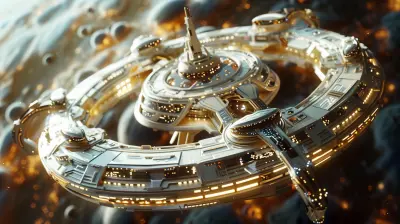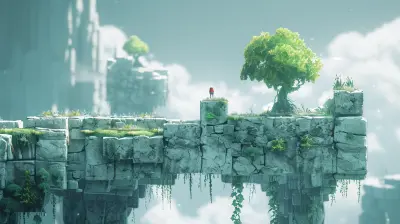Why Pixel Graphics Are Making a Modern Comeback
4 June 2025
Pixel graphics—those chunky, colorful blocks that used to define old-school gaming—are back with a vengeance. If you grew up in the 80s and 90s, there’s a good chance pixel art is your version of “visual comfort food.” But here’s the kicker: even people who didn’t grow up with those classic NES or SNES games are falling in love with the charm of pixel graphics.
Why? What’s fueling this retro-inspired resurgence in the modern gaming world? Grab a cup of coffee, get comfortable, and let’s dive into why pixel art—a style once dictated by technological limitations—is making such a strong comeback.![]()
Pixel Graphics: A Nostalgic Throwback
Let’s start with the obvious—nostalgia. There’s something magical about pixel art that instantly makes people feel like they’re being wrapped in a warm, retro blanket. It takes us back to simpler times, where blowing on game cartridges and memorizing cheat codes were our biggest worries.You ever notice how a single glance at a pixelated heart in a game can suddenly remind you of all those hours you poured into The Legend of Zelda or Final Fantasy? For older gamers, these pixel visuals trigger memories of childhood joy. And because nostalgia is one heck of an emotional rollercoaster, it’s no surprise that pixel graphics hit us right in the feels.
But it’s not just the elder millennials or Gen X gamers driving this trend. Younger generations are catching the pixel fever, perhaps because it’s new to them. For them, it’s less about nostalgia and more about the timeless charm and creativity that pixel art exudes.![]()
Pixel Art: Limitations Breeding Creativity
Let’s be honest—pixel art wasn’t born out of artistic preference. Back in the day, early game developers didn’t have much wiggle room. They had limited color palettes and extremely tiny resolutions to work with. Imagine trying to tell an epic story and design an entire world with a handful of pixels. It’s like painting the Sistine Chapel with kindergarten crayons.But here’s the thing—those limitations forced developers to get creative. It’s what made classic characters like Mario, Sonic, and Mega Man so iconic. Artists had to strip designs down to their essence, creating clean, crisp, and instantly recognizable characters.
Now, fast-forward to today. With modern tech, developers can build ultra-HD worlds so realistic you’d swear you were playing a movie. Yet, many indie studios (and even some big names) are choosing pixel art because they understand its unique ability to capture attention and imagination. You can create an emotional connection with just a few pixels—and that’s some real artistic wizardry.![]()
A Simpler Aesthetic in a Complex World
Let’s face it—modern life is complicated. Between endless notifications, streaming wars, and everyone constantly chasing the next big thing, there’s something refreshingly simple about pixel graphics. It’s like tuning out the noise and turning back the clock to a more straightforward, less chaotic era.Pixel art doesn't try to impress you with over-the-top realism. Instead, it offers a minimalist aesthetic that leaves plenty of room for interpretation. It’s almost as if the simplicity of the style invites you—no, challenges you—to use your imagination. Think of it like reading a great book versus watching a movie. With pixel graphics, there’s always a little bit of storytelling happening in your own brain.![]()
Indie Developers Are Leading the Charge
Here’s where things get really interesting. One of the main reasons pixel graphics are making a comeback is because of indie game developers. Big-budget studios often focus on pushing the limits of photorealistic graphics (and let’s be real, they’ve got millions of dollars at their disposal). Meanwhile, indie developers aren’t shackled to the same expectations. They don’t need to compete with the likes of The Last of Us or Cyberpunk 2077, and pixel art offers them an affordable, yet endlessly creative, solution.Games like Stardew Valley, Celeste, and Undertale have proven that pixel art isn’t just “good enough.” It can carry meaningful stories, evoke strong emotions, and deliver unforgettable experiences. And here’s the best part—these games aren’t just “niche” titles. They’ve found universal appeal, proving that pixel art isn’t just a throwback gimmick; it’s a legitimate artistic choice.
Modern Tools with a Retro Twist
When you think about it, the tools that developers have now are light-years ahead of what the creators of the original Super Mario Bros. had at their disposal. Modern pixel artists can create intricate, detailed worlds that weren’t even possible during the golden age of gaming. Shadows, lighting effects, and even movement animations are all elevated beyond what pixel art could do 30 years ago.Take a look at games like Hyper Light Drifter or Octopath Traveler. These aren’t your traditional 16-bit titles. They combine the charm of pixel graphics with modern-day visual effects to create something entirely new. It’s like taking a retro car and fitting it with a high-performance engine—it looks familiar, but it runs smoother and faster.
The Rise of 'Accessible Gaming'
Pixel art is also inherently more accessible. Picture this: you don’t need a $3,000 gaming rig to enjoy a pixelated masterpiece. These games tend to have lower hardware requirements, meaning they can run smoothly even on older or budget-friendly devices.For gamers who can’t—or don’t want to—invest in high-end hardware, pixel-based games offer a way to enjoy fantastic titles without emptying their wallets. This makes them inclusive and appealing to a broader audience, especially when so many AAA games are pushing for 100GB installs and the latest-gen GPUs.
Pixel Graphics Are Timeless
Sure, photorealistic visuals are jaw-dropping, but they age like milk. What seemed cutting-edge in 2013 might look laughably outdated today. Pixel art, on the other hand, has a timeless quality. A game like Chrono Trigger still looks stunning in its own unique way, even decades after its original release.Pixel art doesn’t try to mimic reality, which is why it doesn’t suffer when technology inevitably advances. It occupies this beautifully nostalgic middle ground that feels both retro and timeless at the same time.
The Role of Streaming and Social Media
Let’s not ignore the impact of streaming platforms like Twitch or YouTube, where personality-driven content creators thrive. Pixel games are often highly stylized, making them visually distinct while being easy to follow for viewers. Whether it’s a fast-paced platformer or a heart-wrenching RPG, pixel graphics have an inherent “watchability” factor that pairs perfectly with creators’ storytelling abilities.Plus, pixel-based games have a quirky, eye-catching presence on social media. Screenshots and fan art of pixel worlds stand out in a sea of hyper-realistic graphics, grabbing attention whether you’re casually scrolling through Twitter or browsing Instagram.
It’s Affordable, But Not Cheap
One of the biggest misconceptions about pixel graphics is that they’re “cheap” or “lazy.” Spoiler alert—they’re not. While it’s true that pixel art doesn’t require the astronomical budgets of AAA 3D games, crafting high-quality pixel art is an art form in its own right.Developers spend countless hours meticulously placing each pixel, ensuring that every frame feels alive and intentional. It’s an art that requires precision, patience, and a deep understanding of design principles. So if anyone tells you that pixel art is “low effort,” feel free to send them a lovingly pixelated middle finger.
Conclusion
So, why are pixel graphics making a modern comeback? It’s a mix of nostalgia, artistic creativity, accessibility, and timeless appeal. It’s a style born out of necessity that has grown into something capable of delivering deeply emotional and artistic experiences. Whether you’re an old-school gamer chasing the past or a modern player discovering pixel art for the first time, one thing is clear: this retro aesthetic isn’t going anywhere anytime soon.Pixel art has proven it’s far more than just a relic of gaming’s early days—it’s a testament to the power of creativity and simplicity in a world that often feels overwhelming. Whether it’s in indie titles, modern re-imaginings, or brand-new creations, pixel graphics are here to stay—and honestly, we’re all better for it.
all images in this post were generated using AI tools
Category:
Retro GamesAuthor:

Greyson McVeigh
Discussion
rate this article
3 comments
Thorne Fry
Pixel graphics are like retro socks - cozy, nostalgic, and surprisingly stylish! In a world of high-def chaos, who wouldn’t want to dive back into those charming 8-bit worlds? Bring on the blocky adventures and quirky charm!
June 11, 2025 at 4:18 PM

Greyson McVeigh
Absolutely! Pixel graphics evoke nostalgia and simplicity, offering a refreshing charm amidst today's hyper-realistic visuals. They invite players into a uniquely creative and playful world!
Phoebe Martin
Who knew nostalgia could pixelate its way back into our hearts? Just when we thought we’d outgrown 8-bit, here comes the retro revolution—proof that sometimes, smaller really is better!
June 8, 2025 at 3:35 PM

Greyson McVeigh
Absolutely! Nostalgia has a powerful way of connecting us to simpler times, and the charm of pixel graphics is making a delightful return in modern gaming and design.
Selkie Perez
Who knew tiny pixels could pack such a punch? It's like going back to grandma’s attic and finding a treasure chest of nostalgia! Let’s embrace the blocky brilliance—after all, every pixel tells a story, even if it’s a pixelated one!
June 5, 2025 at 4:24 AM

Greyson McVeigh
Absolutely! Pixel graphics evoke nostalgia while showcasing creativity—every pixel indeed has a tale to tell!



